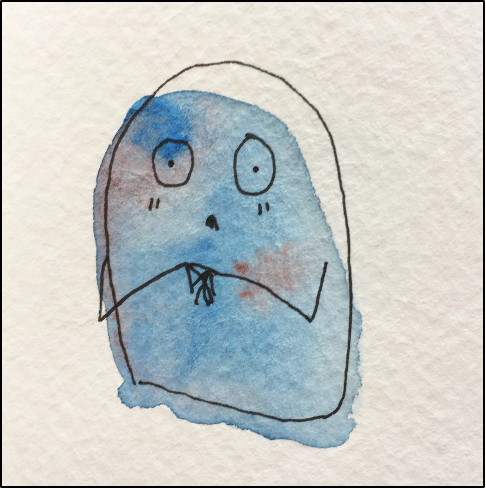When Words Aren’t Enough: My Practice with Art Therapy
By: Julia Heffernan, LCAT, ATR-BC
As a kid, I remember how hard it could be to find the right words for big feelings. A lot of the time, I’d draw instead. Or make up stories. Or just sit quietly near someone who felt safe. I didn’t always have the language, but I was still expressing something real.
“Expectations”, drawn in high school
Now, as a licensed art therapist, I see how often children (and adults!) still need those kinds of non-verbal pathways to healing. That’s where art therapy comes in.
What is art therapy?
Art therapy is a form of psychotherapy that uses the creative process to explore emotions, identity, and experiences. It’s not about making “good” art. It’s about giving form to the things that are hard to say out loud, using images and creative play to access parts of ourselves that might feel stuck or hidden.
A child might draw their anxiety as a monster they can talk to. A teen might build something that reflects how they see themselves. A caregiver and child might create a sand tray scene that quietly tells a story about distance and connection. These creative acts become bridges: between inner and outer worlds, between kids and caregivers, and between client and therapist.
“The Worrier” painted in college
Who is this for?
Art therapy can be helpful for anyone, but I find it especially meaningful for kids and teens navigating things like anxiety, depression, neurodivergence, trauma, gender exploration, or just the general intensity of growing up. It’s also a powerful option for those who feel deeply but don’t always have the words, or who haven’t felt fully understood in other spaces.
A lot of my clients don’t think of themselves as “creative,” and that’s totally okay. Creativity isn’t just about making art. It’s also about how we make sense of the world. And when given the space, most young people have so much inside them just waiting to come out.
What does a session look like?
That really depends, because every child, teen, and family is different.
Some days we use traditional art materials like markers, pencils, paint or clay. Other days, we build with miniatures, role-play, or dive into the sand tray. Sometimes we just sit together, talking and noticing what comes up. There’s often laughter and mess and movement, but also space for quiet. I also integrate psychodynamic talk therapy and play-based approaches to create a flexible, responsive space where the child can lead.
What matters most isn’t what a session looks like, but what it feels like: connected, curious, safe, and attuned.
“Hold Me” painted during COVID19 lockdown
Why this work matters and why this work works
Research shows that art therapy reduces cortisol levels, the stress hormone (Kaimal et al., 2016), increases emotional resilience (Uttley et al., 2015), and even strengthens neural pathways for self-expression (Belkofer et al., 2014). For kids with neurodivergence or developmental differences it’s a way to communicate without the pressure of getting the words right (Schweizer et al., 2017).
Kids deserve spaces where they can be exactly who they are and grow into who they’re becoming. When a person is struggling, they don’t need to be “fixed,” they need to be seen, heard, and supported. That support doesn’t always begin with words. My job is to understand what a child is saying when the words aren’t there, yet, whether that’s through a furious scribble or a carefully built world in the sandtray. Then, with that safety established, I can help kids build understanding about themselves, experiment with different options, and choose how they want to cope, heal, and grow.
Further reading
Belkofer, C. M., et al. (2014). Effects of drawing on right hemispheric activation. Art Therapy, 31(2), 61–68. https://doi.org/10.1080/07421656.2014.903826
Kaimal, G., et al. (2016). Reduction of cortisol levels and participants’ responses following art making. Art Therapy, 33(2), 74–80. https://doi.org/10.1080/07421656.2016.1166832
Schweizer, C., et al. (2017). Art therapy for children with autism spectrum disorder. The Arts in Psychotherapy, 54, 78–84.
https://doi.org/10.1016/j.aip.2017.02.003
Uttley, L., et al. (2015). Systematic review of art therapy. Health Technology Assessment, 19(18). https://doi.org/10.3310/hta19180



